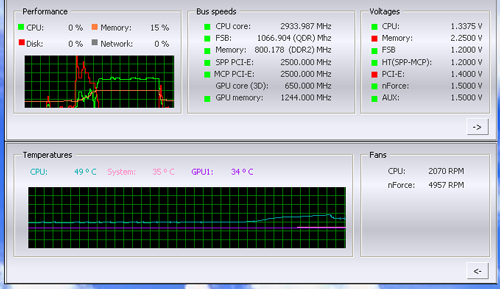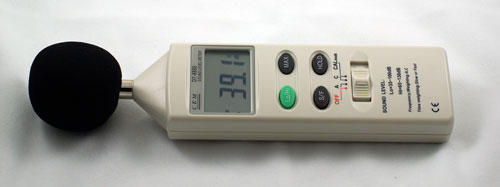Value Cooling: Two Towers for under $30
by Wesley Fink on January 23, 2007 3:50 AM EST- Posted in
- Cases/Cooling/PSUs
CPU Cooling Test Configuration
A requirement for any cooling test bed is a reliable utility for measuring CPU temperature and fan speed. The utility also must be usable while other programs are running so the impact of stress testing can be assessed. After evaluating a number of Intel 975/965 and NVIDIA 680i motherboards the decision was reached to use the NVIDIA 680i as the cooling test bed. This was primarily based on the excellent temperature measurement utility, NVIDIA Monitor, which is part of the nTune program.

NVIDIA Monitor has a drop-down pane for temperature measurement which reports CPU, System, and GPU measurement. At this point we will concentrate primarily on CPU temperature with listings of system temps for reference. In addition to the real-time temperature measurement, NVIDIA Monitor also has a logging feature which can record temperature in a file in standard increments (we selected every 4 seconds). This allows recording of temperatures during testing and play back, for example, of stress test results that can then be examined when the stress tests are completed. There is also the handy reference of speeds and voltages in the top pane to confirm the test setup.
Other components in the cooling test bed are generally the same as those used in our motherboard and memory test bed:
We first tested the stock Intel cooler at standard X6800 speed, measuring the CPU temperature at idle and while the CPU was being stressed. We stressed the CPU by running continuous loops of the Far Cry River demo. The same tests were repeated at the highest stable overclock we could achieve with the stock cooler. Stable in this case meant the ability to handle our Far Cry looping for at least 30 minutes.
The same tests were then run on the cooler under test at stock, highest stock cooler OC speed (3.73GHz), and the highest OC that could be achieved in the same setup with the cooler being tested. This allows measurement of the cooling efficiency of the test unit compared to stock and the improvement in overclocking capabilities, if any, from using the test cooler.
Noise Levels

In addition to cooling efficiency and overclocking abilities, users shopping for CPU cooling solutions may also be interested in the noise levels of the cooling devices they are considering. Noise levels are measured using a C. E. M. DT-8850 Sound Level meter. This meter allows accurate sound level measurements from 35bdB to 130dB with a resolution of 0.1dB and an accuracy of 1.5dB. This is sufficient for our needs in these tests, as measurement starts at the level of a relatively quiet room. Our own test room, with all computers and fans turned off, has a room noise level of 36.4dB.
Our procedures for measuring cooling system noise are described on page 6 along with noise results comparing the stock Intel cooler to the tested coolers.
A requirement for any cooling test bed is a reliable utility for measuring CPU temperature and fan speed. The utility also must be usable while other programs are running so the impact of stress testing can be assessed. After evaluating a number of Intel 975/965 and NVIDIA 680i motherboards the decision was reached to use the NVIDIA 680i as the cooling test bed. This was primarily based on the excellent temperature measurement utility, NVIDIA Monitor, which is part of the nTune program.

NVIDIA Monitor has a drop-down pane for temperature measurement which reports CPU, System, and GPU measurement. At this point we will concentrate primarily on CPU temperature with listings of system temps for reference. In addition to the real-time temperature measurement, NVIDIA Monitor also has a logging feature which can record temperature in a file in standard increments (we selected every 4 seconds). This allows recording of temperatures during testing and play back, for example, of stress test results that can then be examined when the stress tests are completed. There is also the handy reference of speeds and voltages in the top pane to confirm the test setup.
Other components in the cooling test bed are generally the same as those used in our motherboard and memory test bed:
| Cooling Performance Test Configuration | |
| Processor: | Intel Core 2 Duo X6800 (x2, 2.93GHz, 4MB Unified Cache) |
| RAM: | 2x1GB Corsair Dominator PC2-8888 (DDR2-1111) |
| Hard Drive: | Hitachi 250GB SATA2 enabled (16MB Buffer) |
| Video Card: | 1 x EVGA 7900GTX - All Standard Tests |
| Platform Drivers: | NVIDIA 9.53 |
| NVIDIA nTune: | 5.05.22.00 (1/16/2007) |
| Video Drivers: | NVIDIA 93.71 |
| CPU Cooling: | Thermalright MST-9775 Scythe Katana Tuniq Tower 120 Intel Stock HSF for X6800 |
| Power Supply: | OCZ PowerStream 520W |
| Motherboards: | EVGA nForce 680i SLI (NVIDIA 680i) |
| Operating System: | Windows XP Professional SP2 |
| BIOS: | Award P24 (1/12/2007) |
We first tested the stock Intel cooler at standard X6800 speed, measuring the CPU temperature at idle and while the CPU was being stressed. We stressed the CPU by running continuous loops of the Far Cry River demo. The same tests were repeated at the highest stable overclock we could achieve with the stock cooler. Stable in this case meant the ability to handle our Far Cry looping for at least 30 minutes.
| X6800 CPU Operating Temperature Standard Intel Heatsink/Fan (Ambient Temperature 21C (70F) |
||
| CPU | System | |
| IDLE 2.93GHz | 41C (106F) | 32C (90F) |
| STRESS 2.93GHz | 56C (133F) | 33C (91F) |
| IDLE 3.73GHz | 56C (133F) | 37C (99F) |
| STRESS 3.73GHz | 71C (160F) | 38C (100F) |
The same tests were then run on the cooler under test at stock, highest stock cooler OC speed (3.73GHz), and the highest OC that could be achieved in the same setup with the cooler being tested. This allows measurement of the cooling efficiency of the test unit compared to stock and the improvement in overclocking capabilities, if any, from using the test cooler.
Noise Levels

In addition to cooling efficiency and overclocking abilities, users shopping for CPU cooling solutions may also be interested in the noise levels of the cooling devices they are considering. Noise levels are measured using a C. E. M. DT-8850 Sound Level meter. This meter allows accurate sound level measurements from 35bdB to 130dB with a resolution of 0.1dB and an accuracy of 1.5dB. This is sufficient for our needs in these tests, as measurement starts at the level of a relatively quiet room. Our own test room, with all computers and fans turned off, has a room noise level of 36.4dB.
Our procedures for measuring cooling system noise are described on page 6 along with noise results comparing the stock Intel cooler to the tested coolers.










28 Comments
View All Comments
takumsawsherman - Wednesday, January 24, 2007 - link
Why is the Tuniq tower 120 being compared against much cheaper coolers with smaller fans? Why not pit it against the Thermalright HR-01, which would be more of an apples to apples comparison?I am sure that Scythe must have a more worthy competitor as well, though I am not familiar with their line.
LoneWolf15 - Thursday, January 25, 2007 - link
Scythe's Infinity is probably the closest competitor. I believe there may be a few other sites that have reviewed it.
Wesley Fink - Wednesday, January 24, 2007 - link
You neglected to mention that we also compared the performance of the Scythe Katana and Thermalright MST-9775 to the Intel Retail HSF that comes with the Core 2 Duo processor. Until we test a cooler that might perform better than the Tuniq the range of performance is "real-world" between the Intel Retail HSF and the Tuniq. We believe most readers want to know how a tested cooler compares in this rnage - so they can decide if the features or cost are worth the performance drop from the best we have tested.In the future we will be testing some new tower coolers that should challenge the Tuniq. We also plan a value cooler roundup of coolers under $30.
Zoomer - Wednesday, January 24, 2007 - link
Seconded!I'm looking forward to seeing the Arctic Cooler 7 Pro review. In cooler climates with a core2 duo, there is really no need to spend the extra $30 for a huge tower heatsink.
Calin - Wednesday, January 24, 2007 - link
The comparison was between the baseline (the included cooler) and the best air cooler there is (at least known/proven until now).Should the Tuniq Tower be compared to the best air cooled equipments out there? Yes, and it would be nice to compare it to a not very expensive water cooled system too.
Jodiuh - Wednesday, January 24, 2007 - link
Well if that's not reason enough to get a Tuniq.LoneWolf15 - Wednesday, January 24, 2007 - link
Getting one dropped my temps from my old Swiftech by 5-8C when idle and 8-15C under load.It sure was a good enough reason for me. And that's with the fan at a quiet 1400rpm.
And I agree (with what I think you're saying) that, if you're going to spend $30 for an aftermarket cooler, and the Tuniq will fit, why not spend an extra 20-25 for best aftermarket cooler you can get?
Avalon - Tuesday, January 23, 2007 - link
I think it's a good addition to AT to include cooling reviews. However, you guys should see if you can expand temperature gauging a little more to also include PWM temps and other important temperatures, as some HSF solutions have a large affect on these, while others don't.Also, really want to see the Coolermaster Hyper TX in the next roundup!
Vidmar - Tuesday, January 23, 2007 - link
What was the orientation of the CPU/heatsink during the tests? Was the case (and MB) in a horizontal or vertical orientation? Since these new coolers use heatpipes and since the heatpipe technology relies on a liquid that turns to gas when heated then back to liquid when cool, the orientation of the heatsink/heatpipe plays a huge role in how the well it will perform.I would like to think that you are running these tests with the case in a vertical orientation like what a large portion of your readers would be using. But since you never say we don’t know. If these tests are being conducted with the case in a horizontal orientation (laying flat on a table), I would expect that the results would be different than what people would get at home (mostly vertical).
Thanks!
Wesley Fink - Tuesday, January 23, 2007 - link
Noise measurements were run with the case horizontal and an open side. Cooling tests were run with the case in the standard upright position, as our readers will most likely use them at home.